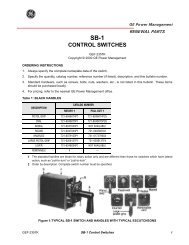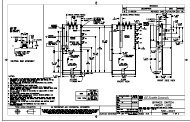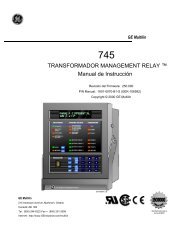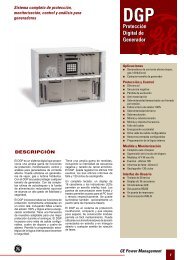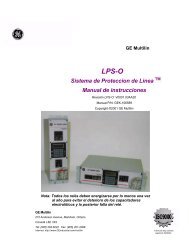944-0140 D20MX Substation Gateway ... - GE Digital Energy
944-0140 D20MX Substation Gateway ... - GE Digital Energy
944-0140 D20MX Substation Gateway ... - GE Digital Energy
You also want an ePaper? Increase the reach of your titles
YUMPU automatically turns print PDFs into web optimized ePapers that Google loves.
LAN redundancy<br />
IP addresses<br />
CHAPTER 3: CONNECTING TO DEVICES AND NETWORKS<br />
Both twisted-pair and fiber optic Ethernet options provide two LAN redundancy schemes<br />
called single-IP redundancy and dual-IP redundancy.<br />
Single-IP redundancy provides automated fail over between two Ethernet network<br />
connections (TX1/RX1 and TX2/RX2) that share a single MAC and IP address.<br />
When the primary port (that is, port 1) receives no signal, or detects a fault signal from the<br />
remote link partner, the <strong>D20MX</strong> switches to the secondary port (that is, port 2) if it has a<br />
valid link. The <strong>D20MX</strong> reverts to the primary port if the primary link is restored or no signal<br />
is present on the secondary port.<br />
With dual-IP redundancy, each port has a unique MAC, IP address and subnet. Each<br />
remote device participating in dual-IP redundancy must have a primary IP address<br />
reachable through the subnet of port 1 of the <strong>D20MX</strong> and a secondary IP address<br />
reachable through the subnet of port 2 of the <strong>D20MX</strong>. <strong>D20MX</strong> client applications will fail<br />
over to the remote device's secondary IP address when they detect a failure to<br />
communicate with the remote device's primary IP address. <strong>D20MX</strong> server applications<br />
accept communications from the remote device's primary or secondary IP address.<br />
To configure a system for single-IP redundancy, enable only LAN A in the device properties<br />
of the <strong>D20MX</strong>. To configure a system for dual-IP redundancy, enable both LAN A and LAN B<br />
in the device properties of the <strong>D20MX</strong>. The <strong>D20MX</strong> device properties may be configured<br />
through SGConfig 7 and higher.<br />
The <strong>D20MX</strong> assigns IP configuration to its LAN A and optionally LAN B interface according<br />
to the rules defined in Table 15.<br />
In a standalone system, the <strong>D20MX</strong> assigns the LAN A and LAN B IP addresses exactly as<br />
you configured them in SGConfig.<br />
In a redundant system, the <strong>D20MX</strong> assigns the LAN A and LAN B IP addresses of the Active<br />
CCU exactly as you configured them in SGConfig.<br />
However, in other modes, the CCU assigns derived IP addresses as indicated in Table 15.<br />
For a description of the modes, refer to Table 17. The <strong>D20MX</strong> assigns the subnet mask of<br />
the derived IP addresses as the subnet mask configured in the LAN A or LAN B<br />
configuration.<br />
Table 15: <strong>D20MX</strong> IP address assignment<br />
CCU Redundant<br />
System<br />
CCU A Standalone Active, Debug<br />
or Disabled<br />
CCU A Redundant Active<br />
CCU B Redundant Active<br />
CCU A Redundant Standby,<br />
Debug or<br />
Disabled.<br />
Mode LAN A IP Configuration LAN B IP Configuration (If<br />
Configured)<br />
IP Address: LAN A IP<br />
Address<br />
Mask: LAN B Subnet Mask<br />
(e.g 192.168.1.1 /<br />
255.255.255.0)<br />
Derived IP Address: LAN A<br />
IP Address + 1<br />
Mask: LAN A subnet mask<br />
(e.g. 192.168.1.2 /<br />
255.255.255.0)<br />
IP Address: LAN B IP<br />
Address<br />
Mask: Configured LAN B<br />
Subnet Mask (e.g.<br />
192.168.2.1 / 255.255.255.0)<br />
Derived IP Address: LAN B<br />
IP Address + 1<br />
Mask: LAN B subnet mask<br />
(e.g. 192.168.2.2 /<br />
255.255.255.0)<br />
44 <strong>GE</strong>NERAL <strong>D20MX</strong> HARDWARE USER’S MANUAL










